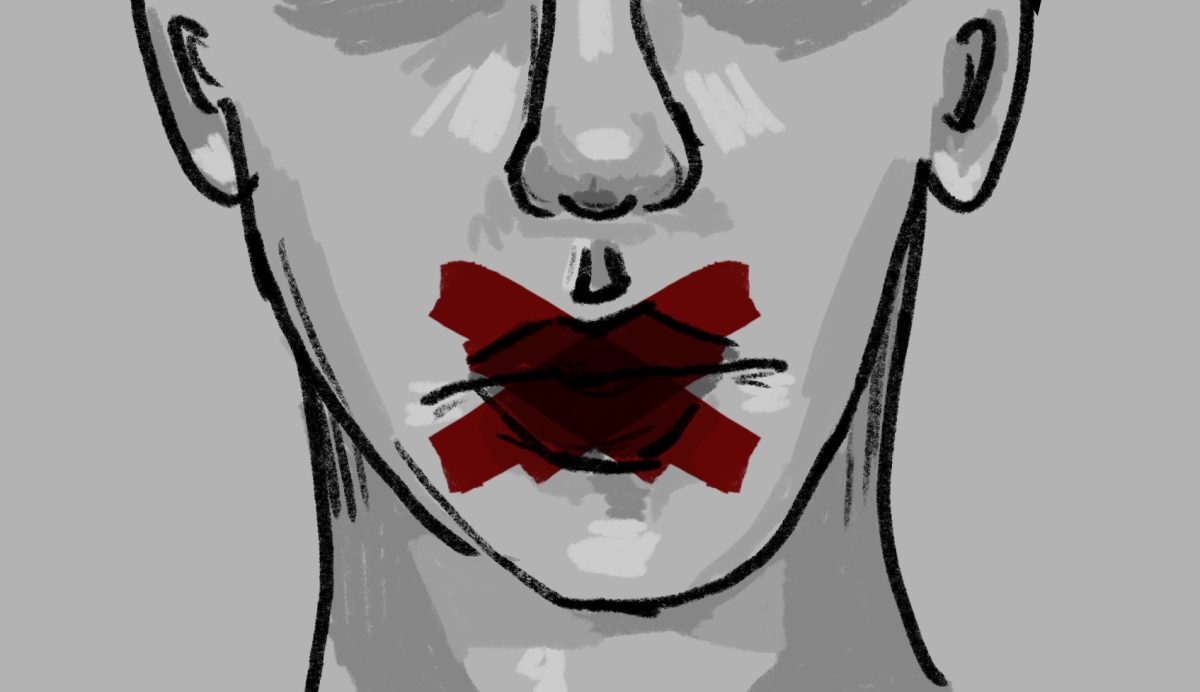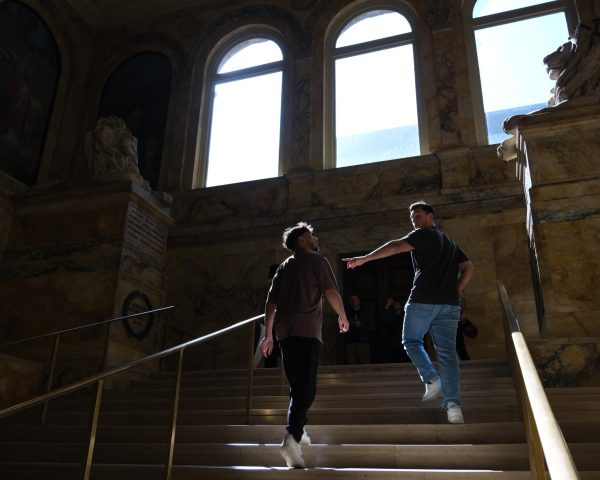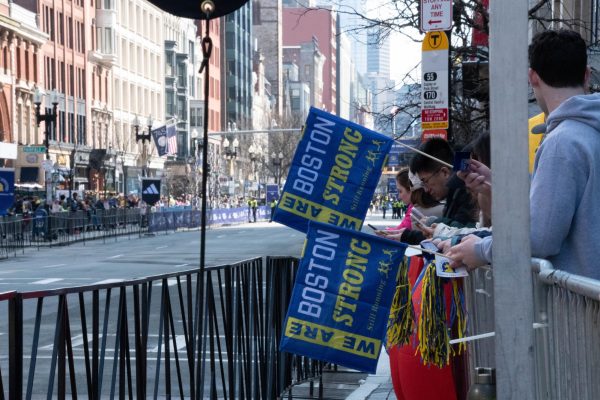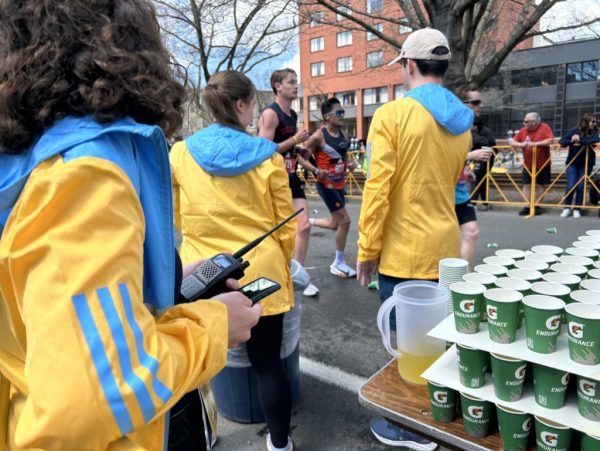Column: Harryween empowers the queer community with style
Harry Styles wore custom Gucci on both nights of Harryween — two Halloween-themed shows of his ongoing “Love on Tour.”
November 8, 2021
As the clock struck 8 p.m. on the night of Oct. 30, the floors of Madison Square Garden, or MSG, were blanketed in the stray feathers of colorful boas from glamorous concert-goers. The night’s costume party called for fans to adorn themselves in ensembles of leather, sequins and fruit-themed accessories galore. A two-year awaited event of spook and style inspired carefully concocted costumes of angels, ghosts (often in pairs of two) and celebrity and Grammy outfit imitations. Among thousands of Harry Styles fans, or Harries, not a single one was there to disappoint —and how could they when the night’s star himself was dressed so memorably?
Harry Styles kicked off the first night of Harryween — a Halloween-themed show of his ongoing “Love on Tour” — with roaring screams for his dainty Dorothy Gale costume. The 27-year-old pop star enchanted the stage as his own yellow brick road, channeling the Judy Garland character in a custom Gucci puff-sleeve gingham dress, rosy pink cheeks, red tights, a matching hair bow and two-tone ruby-slippers.
“I must say, I feel fabulous,” Styles told the crowd, alongside band members also embellished as “Wizard of Oz” characters. The crowd’s back-channeled response of whistles and applause signaled that they thought he looked it, too.
Well-known for his appreciation of gender fluidity within fashion, Styles’ decision to step out in a whimsical dress was not the first of its kind. For his inaugural Vogue cover story in December 2020, Styles wore a variety of stereotypically feminine garments, including skirts and dresses with tux jackets and a crinoline designed by Harris Reed. Though acclaimed by fans and celebrities alike, including Jameela Jamil and Zach Braff, political activist Candace Owens spearheaded the cover’s criticism by voicing the need to “bring back manly men.”
In the face of toxic masculinity, Styles continues to challenge societal norms — sometimes by using fruit as a symbol of sexual fluidity. Sometimes, he even does it in costume.
Styles’ Dorothy costume may have additional layers underneath the dress and petticoat alluding to imagery of queer acceptance. Known widely throughout the LGBTQ+ community, a “friend of Dorothy” euphemistically translates to a label for a queer person. The term most popularly originates from the 1939 film “The Wizard of Oz,” in which Judy Garland (a known gay icon) played the role of Dorothy, a young girl who fully welcomes the unique characters she befriends. En route to the Emerald City, the obstacles faced by Dorothy and her friends are noted to mirror the very obstacles of coming out and having to form a chosen family as a member of the LGBTQ+ community.
Fans were quick to draw allusions to this coded expression as Styles entertained MSG in a bejeweled homage to Garland. Singing his own rendition of “Somewhere Over the Rainbow” later in the night, a melody that famously catalyzed the creation of rainbow symbolism within the LGBTQ+ community, Styles perfected the subtle reference to this sexually-tied slang. In a final flourish of the beauty of Dorothy’s acceptance, Styles enjoyed a dance break during “Treat People With Kindness” with a skip in his ruby-slippered step and a radiant pride flag in hand.
On the second night of Harryween, Styles electrified the stage in the cream silhouette of a clown, wearing another custom Gucci look: a laced, ruffled shirt with sequined moon and star embroideries, a crystal-embellished collar and tiered pants. Though Sunday’s costume party differed from its celebration the night before (imagine a swap from “Somewhere Over the Rainbow” to a cover of Britney Spears’ “Toxic,” for example), the linking of Styles’ costume in relation to queer imagery returned.
Fans were stealthy with their research, beginning with a reference Styles may have made to Pierrot the Clown. A fictional character in the late 17th-century Italian troupe of players performing in Paris, Pierrot wore similarly ruffled and layered garments to Styles’ own costume. Philosophically, Pierrot embodied the struggle of post-revolution France struggling to secure a place in the bourgeois world as a result of overtrusting “clownery.” This is perhaps related to the common doubts that those in the LGBTQ+ community face in trusting a principally diverse world to accept them.
Symbolists thus saw Pierrot as an emblem of suffering, with only the moon for a friend — the very moon threaded onto Styles’ ensemble.
However, the connections do not end there. Filmed in 1950, the short film “Rabbit’s Moon” stars Pierrot in a romantic enchantment for the moon and its resident rabbit, longing to capture it for self fulfillment. Throughout “Love on Tour,” Styles has marketed his fan merchandise and show-opening graphics with a familiar image of two rabbits in the shape of a crescent moon. Could it be that Harryween Night Two delivered a message of Styles’ own dependence on his “Rabbit Moon,” his fans? Are Styles’ fans the moonlight that guides Styles to be his truest and most secure self in fashion, music and identity?
In a world of media and influencer presence that no longer needs to align with black-and-white views of appearance, it is safe to say that “we’re not in Kansas anymore.” Instead, we exist in an evolving, colorful age of changing what is considered normal. Quite beautifully, it is an age prompted by the comforting, understanding relationship Styles shares with his fans (otherwise known as Harries, friends or the moon).
While some may argue that the true fright of Harryween was the picture of a man in dresses and ruffles, other onlookers worldwide see these costumes as the necessary spark for norm-changing conversations. Whether in a dress or a circus costume, Styles pushes the narrative that masculinity and femininity do not need to be zipped into rigid categories. Rather, expressions of gender and sexuality crave fluidity, and this fluidity deserves acceptance.


















